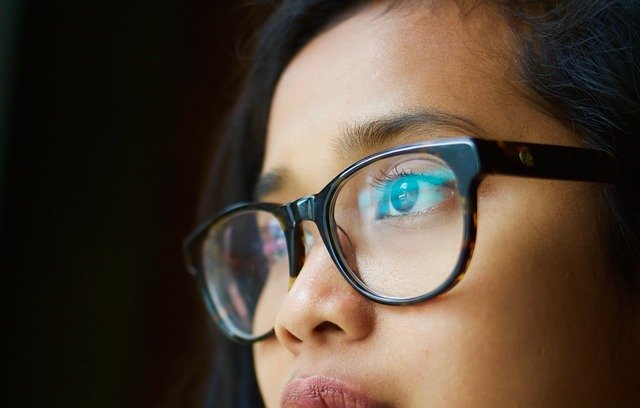If you require an eyeglass prescription to see, there are three main options at your disposal: glasses, contact lenses, and Lasik surgery. These solutions all help focus light onto your retina, but that is where their similarities end. Each has unique pros and cons, and finding the right option can be somewhat tricky. So to help you navigate the complex world of eyecare, we’ve put together your one-stop, ultimate guide to glasses, contacts, and Lasik so that you can find your ideal eyecare match.
At BoydVision, we’re all about helping our customers see clearly, no matter what. If you’re not a suitable candidate for Lasik or our other laser eye surgeries, we will let you know and give you an alternative professional recommendation. The only way to know for sure is to book a free Lasik surgery consultation!
Glasses

Glasses have been helping people see for over 700 years. Their simple design and wide availability often make them people’s first choice when it comes to solving vision issues.
How Much Do Glasses Cost?
The cost of glasses is a difficult number to pin down. Depending on your style, prescription, and how well you take care of your specs, the overall cost will vary. An unfortunate con of glasses is that they can be marked up by up to 1000% because a single manufacturer makes the majority of glasses on the market, they can set the price. Two ex-LensCrafters executives recently said that luxury glasses cost about $10-15 to make, but can sell for over $800 in-store.
So let’s say you’re not looking to buy a fancy pair of D&G glasses. The average price for affordable frames and prescription lenses is around $300. Optometrists recommend updating your glasses every one to three years. Let’s say you purchase a new pair of glasses every other year. Over 50 years, you will have spent $7,500 on glasses. This cost doesn’t account for multiple pairs, breakage, or price fluctuation either. So, while glasses have a relatively low up-front cost, their lifetime cost is quite steep.
Glasses Are Fashionable
One of the great things about glasses is that they make a great fashion accessory. Some people who don’t require glasses choose to wear frames without lenses anyways. There are many celebrities who you can look to when it comes to styles, such as Johnny Depp, Justin Timberlake, Zooey Deschanel, and Julia Roberts, to name a few. Round, square, big, small, colourful, or black, the fashion aspect of glasses is quite unique.
Glasses Limit Functionality
There are some tasks that make wearing glasses just plain annoying. Here’s a shortlist:
- Showering, swimming, or any type of water-related activity
- Boiling water
- Walking around in the rain
- Sports and exercise
- Walking from a cold environment into a warm one
- Any activity that requires wearing goggles, a helmet, or other headgear
Then there’s the fact that glasses tend to go missing and are often dirty. While these things can be classified as small nuisances, they sure make daily living a little tougher.
Glasses – Pros
- Stylish
- Low up-front cost
- Anyone can wear them, even young children
- Widely available
- Protect your eyes from debris
- Unlikely to cause any side effects
Glasses – Cons
- Limited functionality
- Expensive lifetime value
- They can break and go missing easily
- Inconvenient for simple day-to-day tasks
- Limited peripheral vision
Contact Lenses

Contact lenses sit right on your cornea and work the same way as glasses. Light entering your eye is first refracted on the lens, so it is focused correctly onto your retina. Contact lenses are made of hydrophilic plastics, a special type of plastic that stays soft and moist for long periods of time. There are many different types of contact lenses which are designed for either daily or extended wear. The most popular type is the silicone hydrogel contact lens.
How Much Do Contacts Cost?
Like glasses, the cost of contacts can vary greatly depending on your prescription, type of lens, brand, how well you take care of them, and how often they are replaced. In general, even the most affordable contact lenses are more expensive than buying glasses.
For the sake of simplicity, let’s say you buy single-use lenses that cost $60 for a box of 90. This works out to $1.34 each day. Over the course of a year, this will cost you $477.04. If you happen to wear contacts every day for 50 years, you will have spent $23,852 on lenses⏤a pretty hefty price tag!
Contacts Have Some Style
Most contacts are clear, giving you a natural look. However, you can purchase coloured contacts to give your look some style points! Haven’t you ever wanted ocean blue eyes? Well, this is how you can get them.
If you want to freak people out, you can look for special effects contact lenses to have cat eyes, white eyes, differently shaped eyes, etc. You might want to save these for special occasions like Halloween though, since these kinds of lenses cost some more money.
Contact Lenses Need To Be Taken Care Of
Many contact lenses require you to take them out of your eyes when you go to sleep. They must be stored in a contact lens case filled with contact solution. If the lenses are left in your eyes, they can dry out and you may need to throw them out earlier than you had hoped. Typically, contact lens solution will cost you around $100 to $200 per year.
Contacts – Pros
- More freedom than glasses
- Great peripheral vision
- Wide range of lenses available to fit your lifestyle
- Change your eye colour with ease
Contacts – Cons
- Cleaning, inserting, and removing the lenses can be difficult and annoying
- Contact lenses can get lost or easily damaged
- Increased risk of corneal infection
- Some people find wearing contacts uncomfortable
Lasik Eye Surgery

Lasik treatment uses an excimer laser to reshape the cornea and correct any refractive errors. The operation is quick and quite painless. Recovery with Lasik is fast⏤typically our patients are able to return to their regular day-to-day lives after a few days to a week. Some people can return to work the day after surgery.
How Much Does Lasik Cost?
Our custom Lasik procedure costs $1,250 per eye (as of January 2020) or $1450 per eye for no-touch Lasik using a Femto laser. This price includes up to five years of retreatment and a post-op medication kit. Many of our patients only require Lasik once; then they can see clearly for decades. This makes Lasik the most affordable eyecare option over time.
Lasik Gives You A Natural Style
Lasik gives you freedom from glasses and contacts. People will be able to see your face and your true eyes. You’ll be au naturel! But if you want to wear frames without lenses, we won’t judge you.
Lasik Is The Most Functional Option
Lasik surgery removes all of the annoying and mundane tasks associated with glasses and contacts. Walk into any environment you want and your eyewear won’t fog up. Hop in the shower or pool anytime there’s nothing holding you back. Buy those ski goggles you always wanted but never fit over your glasses. Take a nap without having to put your contacts in solution or squishing your frames. After your Lasik procedure, you’ll wonder why you kept wearing glasses and contacts for so long.
Lasik Surgery – Pros
- Fast recovery
- High patient satisfaction and rate of success
- Long-term vision correction
- Low overall cost
- Frees you from glasses and contacts
Lasik Surgery – Cons
- Minor risk of complications
- Night vision may be affected
- Some patients may not qualify
- High up-front cost for the procedure
There you have it our ultimate guide to glasses, contacts, and Lasik. Hopefully, this helps you determine the best course of action for you. Everyone is different, and there is no “one size fits all” solution to eyecare. If you’d like to learn more about Lasik and book a free Lasik consultation, make sure to give us a call at 604.430.9560.
